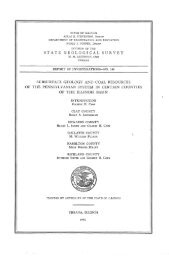2008 ISGS Annual Report - University of Illinois at Urbana-Champaign
2008 ISGS Annual Report - University of Illinois at Urbana-Champaign
2008 ISGS Annual Report - University of Illinois at Urbana-Champaign
Create successful ePaper yourself
Turn your PDF publications into a flip-book with our unique Google optimized e-Paper software.
Energy and Earth Resources<br />
Sequestr<strong>at</strong>ion Potential<br />
<strong>of</strong> Mt. Simon Sandstone<br />
<strong>Illinois</strong> is eminently qualified for the development <strong>of</strong> clean coal technologies.<br />
The st<strong>at</strong>e’s vast coal resources and an excellent potential<br />
sequestr<strong>at</strong>ion resource, the Mt. Simon Sandstone, make the unique<br />
combin<strong>at</strong>ion <strong>of</strong> clean-coal energy production and sequestr<strong>at</strong>ion a<br />
viable opportunity for the future <strong>of</strong> coal energy in <strong>Illinois</strong>.<br />
The sequestr<strong>at</strong>ion potential <strong>of</strong> the Mt. Simon Sandstone continues<br />
to be studied through a $66.7 million contract from the U.S. Department<br />
<strong>of</strong> Energy–N<strong>at</strong>ional Energy Technology Labor<strong>at</strong>ory<br />
(USDOE-NETL) supplemented by co-funding from Archer Daniels<br />
Midland Company (ADM), Schlumberger Carbon Services, and<br />
other corpor<strong>at</strong>e and St<strong>at</strong>e resources.<br />
ADM, Dec<strong>at</strong>ur, <strong>Illinois</strong>.<br />
The Midwest Geological Sequestr<strong>at</strong>ion Consortium (MGSC),<br />
<strong>ISGS</strong>, and ADM are working together on the <strong>Illinois</strong> Basin–Dec<strong>at</strong>ur<br />
carbon sequestr<strong>at</strong>ion project, which will involve the capture and<br />
storage <strong>of</strong> carbon dioxide (CO 2 ) from ADM’s ethanol plant in Dec<strong>at</strong>ur,<br />
<strong>Illinois</strong>. The project is designed to confirm the ability <strong>of</strong> the Mt. Simon<br />
Sandstone, a major regional saline reservoir in <strong>Illinois</strong>, to accept<br />
and store 1 million metric tonnes <strong>of</strong> CO 2 over a period <strong>of</strong> three years.<br />
Carbon dioxide from ADM’s ethanol plant will be injected into a well<br />
drilled to depths exceeding 7,500 feet into the Mt. Simon Sandstone,<br />
where the compressed, liquid-like CO 2 will be stored in the pores<br />
<strong>of</strong> the rock form<strong>at</strong>ion, which is presently s<strong>at</strong>ur<strong>at</strong>ed with w<strong>at</strong>er th<strong>at</strong><br />
is several times saltier than sea w<strong>at</strong>er. The safety and effectiveness<br />
<strong>of</strong> the storage will be monitored by the MGSC through an extensive<br />
monitoring, mitig<strong>at</strong>ion, and verific<strong>at</strong>ion (MMV) program.<br />
The technical qualific<strong>at</strong>ions <strong>of</strong> the Dec<strong>at</strong>ur, <strong>Illinois</strong>, site include one<br />
<strong>of</strong> the best saline reservoirs for carbon sequestr<strong>at</strong>ion in the Midwest,<br />
possibly even in the n<strong>at</strong>ion. The Mt. Simon Sandstone is a thick reservoir,<br />
has a good primary shale seal, and is overlain by two additional<br />
shale units th<strong>at</strong> can act as backup seals. Scientists are confident in<br />
the site and are preparing to conduct a three-dimensional seismic<br />
survey to image the Mt. Simon reservoir to (1) understand the reservoir’s<br />
structural configur<strong>at</strong>ion and (2) correl<strong>at</strong>e its properties to d<strong>at</strong>a<br />
7<br />
from an injection well to better understand the surrounding rock th<strong>at</strong><br />
will contain the carbon dioxide plume. This inform<strong>at</strong>ion will (3) serve<br />
as a baseline for future surveys defining the loc<strong>at</strong>ion <strong>of</strong> the CO 2 in<br />
detail. Such a survey is an essential step to ensure the safety and<br />
integrity <strong>of</strong> any specific geological carbon sequestr<strong>at</strong>ion site and also<br />
to understand the regional configur<strong>at</strong>ion <strong>of</strong> the Mt. Simon.<br />
This knowledge would benefit future bi<strong>of</strong>uels and clean coal projects<br />
loc<strong>at</strong>ed in central <strong>Illinois</strong> as well. The Mt. Simon Sandstone is a major<br />
<strong>Illinois</strong> resource supporting development <strong>of</strong> integr<strong>at</strong>ed coal gasific<strong>at</strong>ion<br />
and sequestr<strong>at</strong>ion. The <strong>Illinois</strong> Basin contains abundant coal<br />
resources suitable for gasific<strong>at</strong>ion, and the more th<strong>at</strong> is understood<br />
about the Mt. Simon, the more assurance there will be th<strong>at</strong> the need<br />
for carbon sequestr<strong>at</strong>ion can be effectively addressed as those coal<br />
resources are being developed.<br />
The <strong>ISGS</strong> has been a leader in geological carbon sequestr<strong>at</strong>ion<br />
research since 2001 and has been researching <strong>Illinois</strong> Basin geology<br />
since the Survey’s formal inception in 1905. The <strong>ISGS</strong>’ extensive<br />
expertise in sequestr<strong>at</strong>ion, Basin geology, environmental geology,<br />
reservoir geology, oil and gas, and coal geology positioned the<br />
Survey to win the USDOE-NETL contract and supported the St<strong>at</strong>e<br />
<strong>of</strong> <strong>Illinois</strong>’ Department <strong>of</strong> Commerce and Economic Opportunity<br />
(DCEO) bid for FutureGen.<br />
The Survey contribution to the FutureGen competition included more<br />
than 40 scientists and staff members who provided geological assessment,<br />
GIS d<strong>at</strong>a, public outreach, general inform<strong>at</strong>ion, and overall<br />
technical support for four <strong>of</strong> the project sites. The <strong>ISGS</strong> helped screen<br />
the 28 original preliminary sites to select the four sites proposed by<br />
<strong>Illinois</strong>, two <strong>of</strong> which were selected as semi-finalists (M<strong>at</strong>toon and<br />
Tuscola). <strong>ISGS</strong> scientists modeled the projected carbon dioxide<br />
plume in the subsurface and conducted two-dimensional seismic<br />
surveys with interpret<strong>at</strong>ion for the selected sites. On December<br />
17, 2007, the FutureGen Alliance selected M<strong>at</strong>toon, <strong>Illinois</strong>, as the<br />
preferred site for the project. Although the project has been temporarily<br />
delayed, the <strong>ISGS</strong> continues to provide technical support for the<br />
preferred selected site <strong>at</strong> M<strong>at</strong>toon, <strong>Illinois</strong>, including evalu<strong>at</strong>ion <strong>of</strong> new<br />
geophysical d<strong>at</strong>a.<br />
Installing Wells for Groundw<strong>at</strong>er<br />
Monitoring and Modeling<br />
Significant progress was made <strong>at</strong> all three active carbon sequestr<strong>at</strong>ion<br />
sites during <strong>2008</strong> as part <strong>of</strong> the Midwest Geological Sequestr<strong>at</strong>ion<br />
Consortium Project, Phase II. At the coal bed site, the third<br />
coal monitor well and<br />
the carbon dioxide<br />
(CO 2 ) injection well in<br />
the Wabash County<br />
project were drilled,<br />
cored, logged, and<br />
cased. Springfield<br />
Coal core samples<br />
from the new monitor<br />
well were placed in<br />
desorption canisters to<br />
evalu<strong>at</strong>e differences in<br />
methane gas content<br />
based on coal maceral<br />
type. Springfield Coal<br />
core from the injection<br />
well was preserved<br />
for use in a display.<br />
<strong>ISGS</strong> drilling and well install<strong>at</strong>ion <strong>at</strong> the ADM site<br />
for the monitoring, mitig<strong>at</strong>ion, and verific<strong>at</strong>ion portion<br />
<strong>of</strong> the deep saline reservoir pilot program.<br />
In June, the wells<br />
were perfor<strong>at</strong>ed, coal<br />
permeability was<br />
measured with w<strong>at</strong>er

















